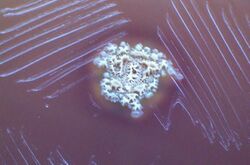Difference between revisions of "Bacillus species - Overview"
Jump to navigation
Jump to search
(Created page with '{{unfinished}} [[File:Bacillus.jpg|right|thumb|250px|<small><center> Unidentified species of Bacillus grown on Blood agar. (Microrao unknown date, Wikimedia commons)</center></…') |
|||
| (10 intermediate revisions by 2 users not shown) | |||
| Line 1: | Line 1: | ||
| − | {{ | + | {{unfinished}} |
| − | |||
| − | |||
| − | |||
| − | |||
| − | |||
| − | |||
| − | |||
| − | }} | ||
[[File:Bacillus.jpg|right|thumb|250px|<small><center> Unidentified species of Bacillus grown on Blood agar. (Microrao | [[File:Bacillus.jpg|right|thumb|250px|<small><center> Unidentified species of Bacillus grown on Blood agar. (Microrao | ||
unknown date, Wikimedia commons)</center></small>]] | unknown date, Wikimedia commons)</center></small>]] | ||
| − | ==Overview== | + | ===Overview=== |
''Bacillus'' species are mostly non-pathogenic, environmental organisms. | ''Bacillus'' species are mostly non-pathogenic, environmental organisms. | ||
| − | ==Characteristics== | + | ===Characteristics=== |
The bacteria are large, motile, Gram positive rods that produce endospores. They are aerobes or facultative anaerobes and are catalase positive and oxidase negative. They grow on non-enriched media. | The bacteria are large, motile, Gram positive rods that produce endospores. They are aerobes or facultative anaerobes and are catalase positive and oxidase negative. They grow on non-enriched media. | ||
| − | ''[[Bacillus anthracis]]'' colonies are up to 5mm diameter, flat, dry and grey with a ground-glass appearance. Curled outgrowths from the edge of the colony give a 'medusa head' appearance. They are non-haemolytic and can be differentiated from ''[[Bacillus cereus]]'' | + | ''[[Bacillus anthracis]]'' colonies are up to 5mm diameter, flat, dry and grey with a ground-glass appearance. Curled outgrowths from the edge of the colony give a 'medusa head' appearance. They are non-haemolytic and can be differentiated from ''[[Bacillus cereus]]''. |
''[[Bacillus licheniformis]]'' forms dull, rough, wrinkled colonies, with hair-like outgrowths. | ''[[Bacillus licheniformis]]'' forms dull, rough, wrinkled colonies, with hair-like outgrowths. | ||
''Bacillus'' species can often tolerate adverse environmental conditions. | ''Bacillus'' species can often tolerate adverse environmental conditions. | ||
| − | + | [[Category:To_Do_-_AimeeHicks]][[Category:Bacillus_species]] | |
| − | |||
| − | |||
| − | |||
| − | |||
| − | |||
| − | |||
| − | [[Category:Bacillus_species | ||
| − | |||
Revision as of 12:47, 21 July 2010
| This article is still under construction. |
Overview
Bacillus species are mostly non-pathogenic, environmental organisms.
Characteristics
The bacteria are large, motile, Gram positive rods that produce endospores. They are aerobes or facultative anaerobes and are catalase positive and oxidase negative. They grow on non-enriched media. Bacillus anthracis colonies are up to 5mm diameter, flat, dry and grey with a ground-glass appearance. Curled outgrowths from the edge of the colony give a 'medusa head' appearance. They are non-haemolytic and can be differentiated from Bacillus cereus. Bacillus licheniformis forms dull, rough, wrinkled colonies, with hair-like outgrowths. Bacillus species can often tolerate adverse environmental conditions.
